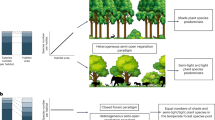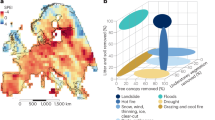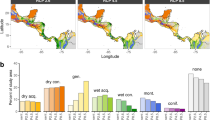Abstract
The benefits and risks of forests to human health are widely recognized. Yet, variation across forest types and their ecological characteristics driving health effects remain underexplored. Based on a continental-scale, interdisciplinary empirical database from 164 European forest stands, we constructed a Bayesian Belief Network to quantify seven causal pathways relating distinct forest types to physical and mental health. These forest–health pathways included mental well-being via visual or auditory stimuli, thermal comfort, polyphenol content of medicinal plants, mushrooms and nutrition, air quality, and ticks and Lyme disease. Results show that forests consistently provide net health benefits regardless of their ecological characteristics. Forest canopy density and tree species diversity emerge as key drivers, but their effect size and directionality are strongly pathway-dependent. Changes in forest canopy density can generate trade-offs. For example, forests optimized for heat buffering and air pollution mitigation may compromise medicinal plant yield and enhance Lyme disease prevalence. Tree diversity effects were weaker but more uniformly positive. Therefore, forest management should account for such trade-offs to tailor forest biodiversity and functioning to local public health priorities.
This is a preview of subscription content, access via your institution
Access options
Access Nature and 54 other Nature Portfolio journals
Get Nature+, our best-value online-access subscription
$32.99 / 30 days
cancel any time
Subscribe to this journal
Receive 12 digital issues and online access to articles
$119.00 per year
only $9.92 per issue
Buy this article
- Purchase on SpringerLink
- Instant access to full article PDF
Prices may be subject to local taxes which are calculated during checkout




Similar content being viewed by others
Data availability
The BBN file that supports the findings of this study is available via Figshare at https://figshare.com/s/63ac8597986bc3d81e2f (ref. 32). It can be used to replicate the findings or for adding new data (belief updating). The individual datasets used to operationalize the BBN are tied to their respective studies, which are cited in the manuscript and listed in the Supplementary Information. Whether data are readily available via repositories or have to be requested from the owners depends on the study.
References
Beute, F. et al. How do different types and characteristics of green space impact mental health? A scoping review. People Nat. 5, 1839–1876 (2023).
Hartig, T., Mitchell, R., de Vries, S. & Frumkin, H. Nature and Health. Annu. Rev. Public Health 35, 207–228 (2014).
Konijnendijk, C., Devkota, D., Mansourian, S. & Wildburger, C. Forests and Trees for Human Health: Pathways, Impacts, Challenges and Response Options. A Global Assessment Report (IUFRO, 2023).
Nature, Biodiversity and Health: An Overview of Interconnections (World Health Organization, 2021).
Reyes-Riveros, R. et al. Linking public urban green spaces and human well-being: a systematic review. Urban For. Urban Green. 61, 127105 (2021).
Noncommunicable Diseases Progress Monitor (World Health Organization, 2022).
Patel, V. et al. The Lancet Commission on global mental health and sustainable development. Lancet 392, 1553–1598 (2018).
Chi, D. et al. Residential exposure to urban trees and medication sales for mood disorders and cardiovascular disease in Brussels, Belgium: an ecological study. Environ. Health Perspect. 130, 057003 (2022).
Iungman, T. et al. Cooling cities through urban green infrastructure: a health impact assessment of European cities. Lancet 401, 577–589 (2023).
Barboza, E. P. et al. Green space and mortality in European cities: a health impact assessment study. Lancet Planet. Health 5, e718–e730 (2021).
van den Berg, M. et al. Health benefits of green spaces in the living environment: a systematic review of epidemiological studies. Urban For. Urban Green. 14, 806–816 (2015).
Nguyen, P.-Y., Astell-Burt, T., Rahimi-Ardabili, H. & Feng, X. Green space quality and health: a systematic review. Int. J. Environ. Res. Public Health 18, 11028 (2021).
De Frenne, P. et al. Global buffering of temperatures under forest canopies. Nat. Ecol. Evol. 3, 744–749 (2019).
Diener, A. & Mudu, P. How can vegetation protect us from air pollution? A critical review on green spaces’ mitigation abilities for air-borne particles from a public health perspective—with implications for urban planning. Sci. Total Environ. 796, 148605 (2021).
Ekkel, E. D. & de Vries, S. Nearby green space and human health: evaluating accessibility metrics. Landsc. Urban Plan. 157, 214–220 (2017).
Dallimer, M. et al. Biodiversity and the feel-good factor: understanding associations between self-reported human well-being and species richness. BioScience 62, 47–55 (2012).
Aerts, R., Honnay, O. & Van Nieuwenhuyse, A. Biodiversity and human health: mechanisms and evidence of the positive health effects of diversity in nature and green spaces. Br. Med. Bull. 127, 5–22 (2018).
Brockerhoff, E. G. et al. Forest biodiversity, ecosystem functioning and the provision of ecosystem services. Biodivers. Conserv. 26, 3005–3035 (2017).
Haines-Young, R. & Potschin, M. in Ecosystem Ecology (eds Raffaelli, D. G. & Frid, C. L. J.) 110–139 (Cambridge Univ. Press, 2010).
Tilman, D., Isbell, F. & Cowles, J. M. Biodiversity and ecosystem functioning. Annu. Rev. Ecol. Evol. Syst. 45, 471–493 (2014).
Marselle, M. R. et al. Pathways linking biodiversity to human health: a conceptual framework. Environ. Int. 150, 106420 (2021).
Marselle, M. R. et al. Urban street tree biodiversity and antidepressant prescriptions. Sci. Rep. 10, 22445 (2020).
Krayenhoff, E. S. et al. Cooling hot cities: a systematic and critical review of the numerical modelling literature. Environ. Res. Lett. 16, 053007 (2021).
Han, D., Shen, H., Duan, W. & Chen, L. A review on particulate matter removal capacity by urban forests at different scales. Urban For. Urban Green. 48, 126565 (2020).
Rozario, K. et al. Perceived biodiversity: is what we measure also what we see and hear? Preprint at bioRxiv https://doi.org/10.1101/2024.04.03.587905 (2024).
Gillerot, L. et al. Forests are chill: the interplay between thermal comfort and mental wellbeing. Landsc. Urban Plan. 242, 104933 (2024).
Rey Gozalo, G., Barrigón Morillas, J. M., Montes González, D. & Atanasio Moraga, P. Relationships among satisfaction, noise perception, and use of urban green spaces. Sci. Total Environ. 624, 438–450 (2018).
Bourdin, A. et al. Forests harbor more ticks than other habitats: a meta-analysis. For. Ecol. Manag. 541, 121081 (2023).
Dudek, T., Kasprzyk, I. & Dulska-Jeż, A. Forest as a place for recreation but also the source of allergenic plant pollen: to come or avoid? Eur. J. For. Res. 137, 849–862 (2018).
Park, B.-J. et al. Relationship between psychological responses and physical environments in forest settings. Landsc. Urban Plan. 102, 24–32 (2011).
Landuyt, D. et al. A review of Bayesian belief networks in ecosystem service modelling. Environ. Model. Softw. 46, 1–11 (2013).
Gillerot, L. et al. Bayesian Belief Network file for the study "Forest biodiversity and structure modulate human health benefits and risks". Figshare https://figshare.com/s/63ac8597986bc3d81e2f (2025).
Zellweger, F. et al. Forest microclimate dynamics drive plant responses to warming. Science 368, 772–775 (2020).
Gillerot, L. et al. Forest structure and composition alleviate human thermal stress. Glob. Change Biol. 28, 7340–7352 (2022).
Wong, N. H., Tan, C. L., Kolokotsa, D. D. & Takebayashi, H. Greenery as a mitigation and adaptation strategy to urban heat. Nat. Rev. Earth Environ. 2, 166–181 (2021).
Verheyen, K. et al. Forest canopies as nature‐based solutions to mitigate global change effects on people and nature. J. Ecol. 112, 2451–2461 (2024).
Ampoorter, E. et al. Tree diversity is key for promoting the diversity and abundance of forest-associated taxa in Europe. Oikos 129, 133–146 (2020).
Stojek, K., Gillerot, L. & Jaroszewicz, B. Predictors of mushroom production in the European temperate mixed deciduous forest. For. Ecol. Manag. 522, 120451 (2022).
Gori, A., Nascimento, L. B., Ferrini, F., Centritto, M. & Brunetti, C. Seasonal and diurnal variation in leaf phenolics of three medicinal Mediterranean wild species: what is the best harvesting moment to obtain the richest and the most antioxidant extracts? Molecules 25, 956 (2020).
Grinfeder, E. et al. Soundscape dynamics of a cold protected forest: dominance of aircraft noise. Landsc. Ecol. 37, 567–582 (2022).
Schulp, C. J. E., Thuiller, W. & Verburg, P. H. Wild food in Europe: a synthesis of knowledge and data of terrestrial wild food as an ecosystem service. Ecol. Econ. 105, 292–305 (2014).
Jansson, M., Fors, H., Lindgren, T. & Wiström, B. Perceived personal safety in relation to urban woodland vegetation—A review. Urban For. Urban Green. 12, 127–133 (2013).
Lai, D. et al. A comprehensive review of thermal comfort studies in urban open spaces. Sci. Total Environ. 742, 140092 (2020).
Steinparzer, M., Haluza, D. & Godbold, D. L. Integrating tree species identity and diversity in particulate matter adsorption. Forests 13, 481 (2022).
Blondeel, H. et al. Light and warming drive forest understorey community development in different environments. Glob. Change Biol. 26, 1681–1696 (2020).
Gray, J. S. Review. The ecology of ticks transmitting Lyme borreliosis. Exp. Appl. Acarol. 22, 249–258 (1998).
Vanneste, T. et al. Trade-offs in biodiversity and ecosystem services between edges and interiors in European forests. Nat. Ecol. Evol. 8, 880–887 (2024).
Vanroy, T. et al. The effect of forest structural complexity on tick-borne pathogens in questing ticks and small mammals. For. Ecol. Manag. 562, 121944 (2024).
Bourdin, A. et al. Forest diversity reduces the prevalence of pathogens transmitted by the tick Ixodes ricinus. Front. Ecol. Evol. https://doi.org/10.3389/fevo.2022.891908 (2022).
Ostfeld, R. S. & Keesing, F. Effects of host diversity on infectious disease. Annu. Rev. Ecol. Evol. Syst. 43, 157–182 (2012).
Steinparzer, M., Schaubmayr, J., Godbold, D. L. & Rewald, B. Particulate matter accumulation by tree foliage is driven by leaf habit types, urbanization- and pollution levels. Environ. Pollut. 335, 122289 (2023).
Cao, Z., Zhou, J., Li, M., Huang, J. & Dou, D. Urbanites’ mental health undermined by air pollution. Nat. Sustain. 6, 470–478 (2023).
Health at a Glance: Europe 2022. State of Health in the EU Cycle (Organisation for Economic Co-operation and Development, 2022).
Ballester, J. et al. Heat-related mortality in Europe during the summer of 2022. Nat. Med. 29, 1857–1866 (2023).
Freer-Smith, P. et al. Plantation Forests in Europe: Challenges and Opportunities (European Forest Institute, 2019); https://doi.org/10.36333/fs09
Planning Improvements in Natural Resources Management: Guidelines for Using Bayesian Networks to Support the Planning and Management of Development Programmes in the Water Sector and Beyond (Centre for Ecology & Hydrology, 2001).
Bratman, G. N. et al. Nature and mental health: an ecosystem service perspective. Sci. Adv. 5, eaax0903 (2019).
Sohn, J. A., Saha, S. & Bauhus, J. Potential of forest thinning to mitigate drought stress: a meta-analysis. For. Ecol. Manag. 380, 261–273 (2016).
Kilpatrick, A. M., Salkeld, D. J., Titcomb, G. & Hahn, M. B. Conservation of biodiversity as a strategy for improving human health and well-being. Philos. Trans. R. Soc. Lond. B Biol. Sci. 372, 20160131 (2017).
Jactel, H., Moreira, X. & Castagneyrol, B. Tree diversity and forest resistance to insect pests: patterns, mechanisms and prospects. Annu. Rev. Entomol. 66, 277–296 (2021).
Baeten, L. et al. A novel comparative research platform designed to determine the functional significance of tree species diversity in European forests. Perspect. Plant Ecol. Evol. Syst. 15, 281–291 (2013).
De Groote, S. R. E. et al. Tree species identity outweighs the effects of tree species diversity and forest fragmentation on understorey diversity and composition. Plant Ecol. Evol. 150, 229–239 (2017).
Paquette, A. et al. A million and more trees for science. Nat. Ecol. Evol. 2, 763–766 (2018).
Nickmans, H. The Nutrition of Oak and Beech Trees along A Tree Diversity Gradient. PhD thesis, Université Catholique de Louvain (2019).
Jensen, F. V. & Nielsen, T. D. Bayesian Networks and Decision Graphs (Springer, 2007).
Aguilera, P. A., Fernández, A., Fernández, R., Rumí, R. & Salmerón, A. Bayesian networks in environmental modelling. Environ. Model. Softw. 26, 1376–1388 (2011).
Marcot, B. G., Steventon, J. D., Sutherland, G. D. & McCann, R. K. Guidelines for developing and updating Bayesian belief networks applied to ecological modeling and conservation. Can. J. For. Res. 36, 3063–3074 (2006).
Netica Application User’s Guide (Norsys Software Corporation, 1998).
R Core Team. R: A Language and Environment for Statistical Computing (R Foundation for Statistical Computing, 2024).
Pascual, U. et al. Valuing nature’s contributions to people: the IPBES approach. Curr. Opin. Environ. Sustain. 26–27, 7–16 (2017).
Uusitalo, L. Advantages and challenges of Bayesian networks in environmental modelling. Ecol. Modell. 203, 312–318 (2007).
Kuhnert, P. M., Martin, T. G. & Griffiths, S. P. A guide to eliciting and using expert knowledge in Bayesian ecological models. Ecol. Lett. 13, 900–914 (2010).
Chen, S. H. & Pollino, C. A. Good practice in Bayesian network modelling. Environ. Model. Softw. 37, 134–145 (2012).
Rozario, K. et al. The more the merrier? Perceived forest biodiversity promotes short-term mental health and well-being—A multicentre study. People Nat. 6, 180–201 (2024).
Cuentas Romero, A. G. et al. Sense of place matters: mental well-being effects of acoustic diversity differ for local and non-local forest soundscapes. Preprint at PsyArxix https://doi.org/10.31234/osf.io/yqcwp (2025).
Gillerot, L., Landuyt, D., De Frenne, P., Muys, B. & Verheyen, K. Urban tree canopies drive human heat stress mitigation. Urban For. Urban Green. 92, 128192 (2024).
World Atlas (GIS Geography) https://gisgeography.com/category/world-atlas/ (2024).
Acknowledgements
We thank all study participants. This research was funded by the ERA-Net BiodivERsA project Dr.FOREST, the German Research Foundation (no. 428795724), the French National Research Agency, Research Foundation-Flanders, the Austrian Science Fund and the National Science Center (project no. 2019/31/Z/NZ8/04032) as part of the 2018–2019 BiodivERsA call for research proposals. P.D.F. received funding from the European Research Council (ERC) under the European Union’s Horizon 2020 research and innovation programme (ERC Starting Grant FORMICA 757833). D.L. was supported by a postdoctoral fellowship of Research Foundation-Flanders. T.V. was supported by a UGent GOA project (no. BOF20/GOA/009). Q.P. thanks the Walloon forest service (Service Public de Wallonie-Département de la Nature et des Forêts) for supporting the maintenance of the FORBIO-Gedinne experiment within the framework of the 5-year research programme ‘Plan Quinquennal de Recherche et de Vulgarisation Forestières’.
Author information
Authors and Affiliations
Contributions
L.G., D.L., B.M. and K.V. conceptualized the statistical approach and developed the methodology. L.G., D.L., A. Bourdin, K.R., T.S., M.S., K.S., T.V., A.G.C.R., S.M., R.R.Y.O., A. Bonn, H.B., D.G., D.H., H.J., B.J., M.R.M., Q.P., M.S.L., B.M. and K.V. developed the outlines of the conceptual models (phase I). L.G., D.L., A. Bourdin, K.R., T.S., M.S., K.S., T.V., A.G.C.R., S.M., R.R.Y.O. shared and prepared the empirical data, quantified the submodels and validated the behaviour model (phases II and III). L.G. and D.L. conducted the data analyses. L.G. wrote the original manuscript draft and all authors reviewed the manuscript. D.L., P.D.F., B.M. and K.V. supervised the study. S.M., D.B., A. Bonn, H.B., D.G., D.H., H.J., B.J., M.R.M., Q.P., M.S.L., B.M. and K.V. obtained the funding and administered the project. M.S.L. and D.H. coordinated the project.
Corresponding author
Ethics declarations
Competing interests
The authors declare no competing interests.
Peer review
Peer review information
Nature Sustainability thanks Brendan Fisher and the other, anonymous, reviewer(s) for their contribution to the peer review of this work.
Additional information
Publisher’s note Springer Nature remains neutral with regard to jurisdictional claims in published maps and institutional affiliations.
Supplementary information
Supplementary Information
Supplementary Methods and Fig. 1.
Rights and permissions
Springer Nature or its licensor (e.g. a society or other partner) holds exclusive rights to this article under a publishing agreement with the author(s) or other rightsholder(s); author self-archiving of the accepted manuscript version of this article is solely governed by the terms of such publishing agreement and applicable law.
About this article
Cite this article
Gillerot, L., Landuyt, D., Bourdin, A. et al. Forest biodiversity and structure modulate human health benefits and risks. Nat Sustain 8, 485–497 (2025). https://doi.org/10.1038/s41893-025-01547-3
Received:
Accepted:
Published:
Issue date:
DOI: https://doi.org/10.1038/s41893-025-01547-3



